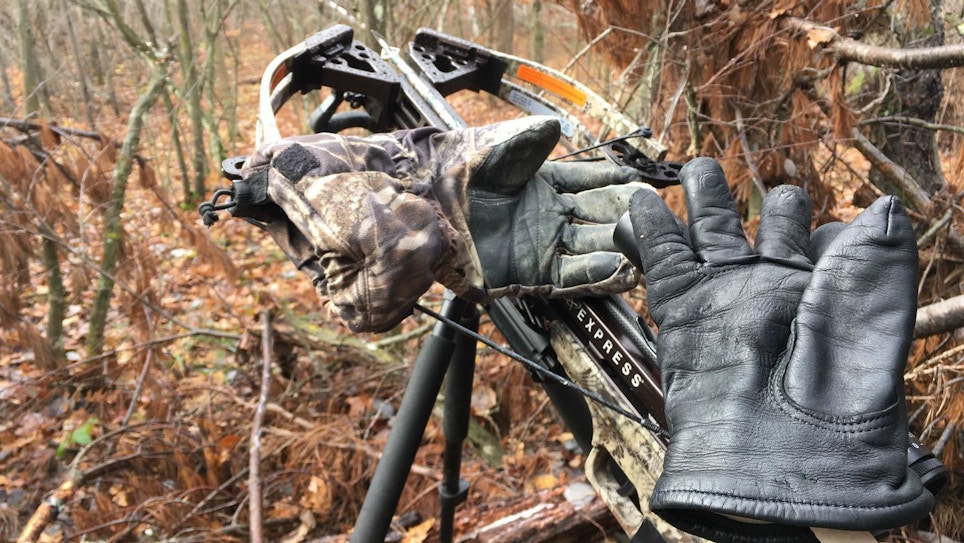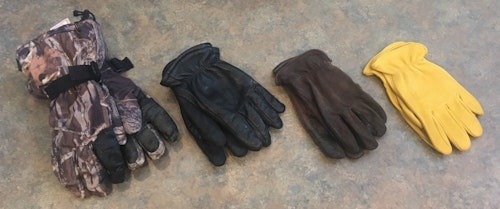
The author took this photo while deer hunting recently in Wisconsin. There’s a reason why his two gloves don’t match.
This article isn’t a product roundup containing every hunting glove brand known to man, and it’s not a technical deep-dive into fabrics and insulation types. Instead, I’ll simply explain what I wear in Minnesota, South Dakota and Wisconsin during November and December deer hunts, and provide reasons why.
As you can see in the photo above, I don’t always wear the same gloves on both hands, and this is true regardless of whether I’m hunting with a gun or crossbow. (I’ll save my glove system when shooting a compound bow for a future article.) The reason for my non-matching choice is a super-thick glove’s index finger won’t fit easily inside the trigger guard for certain rifles and crossbows.
When I snapped the top photo, the air temperature was 25 degrees. The camo glove on the left is thicker and warmer than the black glove on the right. Both gloves are insulated and do a decent job of keeping my hands warm, but the black glove has an index finger that’s just thin enough to fit inside the trigger guard of my crossbow.
Specifically, the camo glove shown is at least 20 years old. It’s a Gore-Tex model from Cabela’s and features Thinsulate insulation. The glove’s exterior is very quiet, the palms are leather, and I have excellent feel while wearing them. That said, I wear only the left glove from the pair, not the right. The reason is that with this Carbon Express crossbow, I can’t fit the Cabela’s right camo glove inside the trigger guard without significant effort; the fit is too tight. When a deer suddenly appears and I need to get ready to aim and shoot, the last thing I want on my mind is worrying about carefully working my gloved index finger into the trigger guard.
(FYI: I recently checked out the Cabela’s website and I think the model currently offered that is closest to what I own is the company’s Extreme II Gore-Tex Shooting Gloves.)
The black glove is made of deer skin and also has Thinsulate insulation. It’s also soft and quiet, and even though it’s not waterproof, I treat the leather with Sno-Seal wax so it is water-resistant. Most importantly, the index finger of the deer skin glove is thin enough so I can quickly and easily slide it inside the crossbow’s trigger guard in preparation for a shot.
(FYI: The company that built my black deer skin gloves is no longer in business. If I needed to buy a replacement pair, I’d check out the ones made in my home state of Minnesota by Century Leather Products. I think the traditional light-tan color of deer skin gloves is too bright for deer hunting, so I prefer black or dark-brown ones.)

During extremely cold conditions (single digits or below zero), I’ll wear a muff and place my gloved hands (these same gloves) inside the muff, then remove them only when I spot a deer. I’m not a fan of using disposable hand warmers because they make my hands feel wet/clammy.
When temperatures are 32 to 50, I’ll wear insulated deer skin gloves on both hands because I don’t need the additional warmth provided by the thicker Cabela’s gloves. When temps are higher than 50, I’ll switch to non-insulated deer skin gloves. Note: I find that deer skin gloves provide me with more feel, especially on the trigger, than cow hide or other leather gloves. They also stretch a bit over time, providing that perfect fit-like-a-glove sensation.
This fall and winter, think about which gloves will keep you warm and dry during deer hunts, and also consider whether they’ll work well inside the trigger guard of your gun or crossbow.





